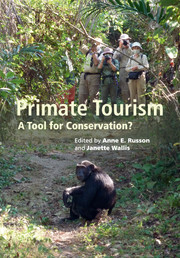Book contents
- Frontmatter
- Contents
- List of contributors
- Part I Introduction
- Part II Asian primates
- Part III African primates
- Part IV Neotropical primates
- 12 The impact of tourist group size and frequency on Neotropical primate behavior in Tambopata, Peru
- 13 Interactions between tourists and white-faced monkeys (Cebus capucinus) at Manuel Antonio National Park, Quepos, Costa Rica
- 14 Effects of tourism on Ecuadorian primates
- Part V Broader issues
- Part VI Conclusion
- Index
- References
12 - The impact of tourist group size and frequency on Neotropical primate behavior in Tambopata, Peru
from Part IV - Neotropical primates
Published online by Cambridge University Press: 05 September 2014
- Frontmatter
- Contents
- List of contributors
- Part I Introduction
- Part II Asian primates
- Part III African primates
- Part IV Neotropical primates
- 12 The impact of tourist group size and frequency on Neotropical primate behavior in Tambopata, Peru
- 13 Interactions between tourists and white-faced monkeys (Cebus capucinus) at Manuel Antonio National Park, Quepos, Costa Rica
- 14 Effects of tourism on Ecuadorian primates
- Part V Broader issues
- Part VI Conclusion
- Index
- References
Summary
Introduction
Nature-based tourism, defined as “all tourism directly dependent on the use of natural resources in a relatively undeveloped state, including scenery, topography, water features, vegetation and wildlife” (Ceballos-Lascurain, 1996), is frequently described as one of the fastest growing sectors of the global tourism sector (Balmford et al., 2009). Its non-extractive nature may lead to the assumption that it is inherently sustainable, yet nature tourism typically occurs in fragile environments and may open up previously undiscovered destinations to the mass market. The mass market then repeatedly and actively seeks out resident wildlife (Jacobson & Figueroa-Lopez, 1994). Often little is known of nature tourism’s true impacts on the biological and physical environment and only rarely are these quantified (Blanc et al., 2006; Roe et al., 1997). This study explored the effects that the presence of tourists can have on the behavior of Neotropical primates of the Tambopata-Candamo Reserved Zone, southeast Peru, and then discusses the implications of these results for nature tourism management in the area.
Numerous studies have shown the strong effect that human presence, in any capacity, may have on wild animal behavior. Cheetahs (Acinonyx jubatus) may alter their feeding time to coincide with periods of low tourist density (Gakahu, 1992); bottlenose dolphins (Tursiops truncatus) have been found to spend significantly less time resting in the presence of tourist boats (Constantine et al., 2004); polar bears (Ursus maritimes) increased their vigilance in the presence of vehicles (Dyck & Baydack, 2004); and Asian rhinoceros (Rhinoceros unicornis) responded to the presence of elephant-borne tourists by spending more time on alert, at the cost of feeding (Lott & McCoy, 1995). More clearly associated with longer-term impacts, yellow-eyed penguin chicks (Megadyptes antipodes) and juvenile hoatzins (Opisthocomus hoazin) that were visited regularly by tourists displayed lowered body weight, which is directly correlated with an increased risk of mortality (McClung et al., 2004; Mullner et al., 2004). Similarly, a long-term study of wood turtle (Clemmys insculpta) numbers showed a clear population decline coinciding with the growth of human activity levels in their area (Garber & Burger, 1995).
- Type
- Chapter
- Information
- Primate TourismA Tool for Conservation?, pp. 215 - 229Publisher: Cambridge University PressPrint publication year: 2014
References
- 1
- Cited by

